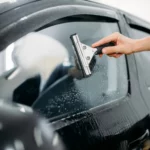
Roundabouts are circular junctions that are usually designed to enable traffic to keep moving without the necessity of stopping. Usually, all the traffic travels clockwise from right to left. These roundabouts come in various sizes and may even come with traffic lights. Many beginner drivers are often daunted at the thought of driving by a roundabout. But with the right know-how and experience, driving through circular junctions will soon become second nature. A beginner can take driving lessons from a DVSA approved instructor. Read about the cost of driving lessons in UK.
However, before learning how to drive at roundabouts, let’s understand the difference between traffic circles and roundabouts. Often the two are used interchangeably by learner drivers, but they are not the same. Traffic circle rules are different from that of roundabouts.
Roundabouts act as a circular intersection that governs multiple roads effectively without the need for traffic lights. They not only boost traffic flow efficiency but also make the intersection safer for drivers. It minimises the risk of a T-bone or a head-on collision, which is the most dangerous type of car accident. A traffic circle, on the other hand, is a circular road that helps in joining other roads at a 90° angle. Traffic circles are often designed for aesthetic purposes rather than boosting traffic flow or reducing accidents.
What is the purpose of roundabouts?
When two or more busy roads with heavy traffic intersect, it is important to find a way to keep the traffic moving. Roundabouts speed up the journey time and ease congestion.
They are also safer than crossroads and traditional junctions as drivers can be tempted to ignore red lights. On roundabouts, all the traffic moves in the same direction which makes manoeuvres such as right turns easier.
How do roundabouts work?
Roundabouts allow you to wait for a safe gap and join the flow of the traffic. You can then continue driving in the correct lane until you reach your exit. However, it is essential to signal before you exit the roundabout.
Moreover, it is often recommended to use a roundabout when performing a U-turn. Larger roundabouts usually consist of different lanes. It is essential to join a roundabout in the appropriate lane to access your desired exit.
A typical roundabout comes with three or four exits. However, some may even have as many as seven or even as few as two.
Choosing the Correct Lane at a Roundabout
You will get to know that you are approaching a roundabout when you spot a red triangle warning sign with a small black circular emblem. However, some roundabouts may come with a warning sign.
Mini-roundabouts usually have a blue circle sign with three small white circular arrows. Mini roundabouts have the same functionality as larger ones but they may be positioned in narrower residential areas.
Road markings in the shape of arrows work jointly with road signs at the roundabout to indicate which lanes go where on each particular roundabout.
After reaching the roundabout, you have to decide whether to continue moving or to stop depending on the traffic conditions. Moreover, it is essential to select the correct gear.
Give way to traffic approaching you from the right:
Make sure to signal in the direction you are going to take before approaching the roundabout unless you are driving straight on, in which case you are not required to signal until you cross the exit before the main exit that you are going to use.
If the roundabout has already standing traffic, you can enter it only if you are not going to block any exits or entrances.
Turning left
If you are about to take a left turn at a roundabout you must approach the left lane. You should remain in the left lane when you are on the roundabout the entire time. Make sure to leave your indicator on and exit the roundabout using the first exit.
Continuing straight ahead
Often you may just want to travel straight through the roundabout. Depending on the roundabout’s size, you may be able to use the left-hand lane to head straight. However, if the roundabout has a sign indicating that you will be able to take the left lane only if you are taking left turns, then you can not use the left lane while heading straight.
Moreover, often larger roundabouts may come with designated lanes to head straight through the roundabout. It is essential to check the road markings at the roundabout.
Just after taking the first exit, make sure to check your main mirror and then the left door mirror. Signal left and take the exit only if the roundabout is clear.
Turning Right
If you wish to make a right turn at a runabout, you must travel to the exit using the right-hand lane. Continue driving in the right-hand lane until you cross the second exit.
Check the main mirror, the left door mirror, and then signal left.
You are required to drive into the left lane before you exit. This makes it essential to check your blind spot with a quick look over your left shoulder. Once you have reached the left lane, you can exit the roundabout.
Larger roundabouts may come with multiple lanes. Make sure to use the most appropriate lane while taking an exit. If you want to take a left turn, take the left lane, for right turns use the right lane, and for moving straight, take the centre lane. If you are required to change lanes, make sure to check blind spots and mirrors while signalling properly.
How to Drive at Roundabouts: Summing Up
Some larger roundabouts often come with traffic lights as well to ease the flow of traffic and enable drivers to get on a busy roundabout. Such roundabouts are more common near motorways. It is essential to understand that roundabouts can be taxing. If you enter the wrong lane, especially when you take a right turn, you may fail to exit safely at the desired point. In such cases, signal right, go around and make better preparations this time. However, with practice and patience, you can easily master driving at a roundabout.






